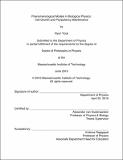| dc.contributor.advisor | Alexander van Oudenaarden. | en_US |
| dc.contributor.author | Youk, Hyun | en_US |
| dc.contributor.other | Massachusetts Institute of Technology. Dept. of Physics. | en_US |
| dc.date.accessioned | 2011-05-09T13:59:31Z | |
| dc.date.available | 2011-05-09T13:59:31Z | |
| dc.date.copyright | 2010 | en_US |
| dc.date.issued | 2010 | en_US |
| dc.identifier.uri | http://hdl.handle.net/1721.1/62604 | |
| dc.description | Thesis (Ph. D.)--Massachusetts Institute of Technology, Dept. of Physics, 2010. | en_US |
| dc.description | This electronic version was submitted by the student author. The certified thesis is available in the Institute Archives and Special Collections. | en_US |
| dc.description | Cataloged from student-submitted PDF version of thesis. | en_US |
| dc.description | Includes bibliographical references. | en_US |
| dc.description.abstract | A persistent challenge in quantitatively modeling a biological system is that the system often involves many components and just as dizzying number of interactions among those components. To further complicate matters, the parameters that characterize those interactions and components, like the rates of chemical reactions and concentrations of molecules inside the cell, have evaded detection by the conventional experimental tools. How does one model a system whose crucial parameters are unknown? And even if we know all the parameters inside the cell, there is an increasing uneasiness among many researchers that just writing down an equation for every interaction and components of the system is not practical. Crucially, it is not clear that such an extensive many-parameter model would always enhance our understanding of the complex biological system. A phenomenological model that involves just a few essential, easily measurable parameters that capture the essence of the complex biological system may provide insights that a many-parameter, large scale model may not provide. In this thesis, we describe our attempts at obtaining such a model for two complex biological systems: 1.) Cell growth as a result of glucose metabolism, and 2.) in vitro maintenance of the embryonic stem cell's pluripotency by a complex transcriptional network. | en_US |
| dc.description.statementofresponsibility | by Hyun Youk. | en_US |
| dc.format.extent | 139 p. | en_US |
| dc.language.iso | eng | en_US |
| dc.publisher | Massachusetts Institute of Technology | en_US |
| dc.rights | M.I.T. theses are protected by
copyright. They may be viewed from this source for any purpose, but
reproduction or distribution in any format is prohibited without written
permission. See provided URL for inquiries about permission. | en_US |
| dc.rights.uri | http://dspace.mit.edu/handle/1721.1/7582 | en_US |
| dc.subject | Physics. | en_US |
| dc.title | Phenomenological models in biological physics : cell growth and pluripotency maintenance | en_US |
| dc.type | Thesis | en_US |
| dc.description.degree | Ph.D. | en_US |
| dc.contributor.department | Massachusetts Institute of Technology. Department of Physics | |
| dc.identifier.oclc | 713659214 | en_US |
